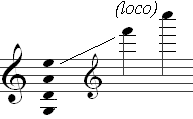
A mandolin is a stringed musical instrument in the lute family and is usually plucked with a plectrum. It commonly has four courses of doubled metal strings tuned in unison, although five and six course versions also exist. The courses are typically tuned in a succession of perfect fifths, with the same tuning as a violin. It is the soprano member of a family that includes the mandola, octave mandolin, mandocello and mandobass.

The mandola or tenor mandola is a fretted, stringed musical instrument. It is to the mandolin what the viola is to the violin: the four double courses of strings tuned in fifths to the same pitches as the viola, a fifth lower than a mandolin. The mandola, although now rarer, is the ancestor of the mandolin, the name of which means simply "little mandola".
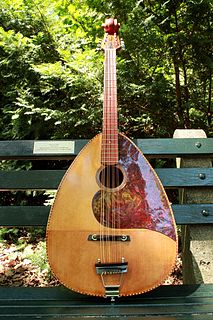
The mandocello is a plucked string instrument of the mandolin family. It is larger than the mandolin, and is the baritone instrument of the mandolin family. Its eight strings are in four paired courses, with the strings in each course tuned in unison. Overall tuning of the courses is in fifths like a mandolin, but beginning on bass C (C2). It can be described as being to the mandolin what the cello is to the violin.
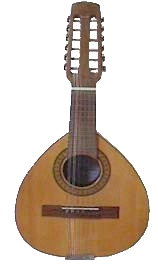
The bandurria is a plucked chordophone from Spain, similar to the mandolin, primarily used in Spanish folk music, but also found in former Spanish colonies.

The mandolin-banjo is a hybrid instrument, combining a banjo body with the neck and tuning of a mandolin or violin. It is a soprano banjo. It has been independently invented in more than one country, being called banjolin and banjourine in English-speaking countries, banjoline and bandoline in France, and the Cümbüş in Turkey.

The octave mandolin is a fretted string instrument with four pairs of strings tuned in fifths, G, D, A, E, an octave below a mandolin. It is larger than the mandola, but smaller than the mandocello and its construction is similar to other instruments in the mandolin family. Usually the courses are all unison pairs but the lower two may sometimes be strung as octave pairs with the higher-pitched octave string on top so that it is hit before the thicker lower-pitched string. Alternate tunings of G, D, A, D and A, D, A, D are often employed by Celtic musicians.

Mandobass is the largest member of the mandolin family, sometimes used as the bass instrument in mandolin orchestras. It is so large that it usually isn't held in the lap, but supported on a spike that rests on the floor. The neck-scale length on a full-size mando-bass is similar to that of a standard orchestral double bass viol: about 43" (110 cm). The instrument is otherwise similar to the smaller, higher-pitched members of the mandolin family, having a fretted neck, a headstock with geared tuning machines, and a large resonating body often—but not always—shaped like that of other mandolins.
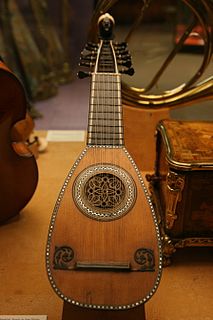
The mandore is a musical instrument, a small member of the lute family, teardrop shaped, with four to six courses of gut strings and pitched in the treble range. Considered a French instrument, with many of the surviving music coming from France, it was used across "Northern Europe" including Germany and Scotland. Although it went out of style, the French instrument has been revived for use in classical music. The instrument's most commonly played relatives today are members of the mandolin family and the bandurria.
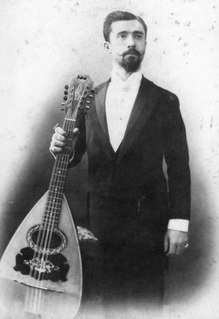
Raffaele Calace was an Italian mandolin player, composer, and luthier.
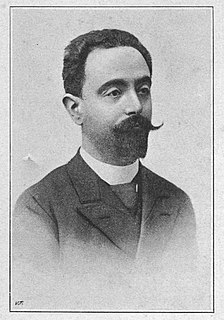
Carlo Munier (1858–1911) was an Italian musician who advocated for the mandolin's acknowledgement among as an instrument of classical music and focused on "raising and ennobling the mandolin and plectrum instruments". He wanted "great masters" to consider the instrument and raise it above the level of "dilettantes and street players" where it had been stuck for centuries. He expected that the mandolin and guitar would be taught in serious orchestral music schools and incorporated into the orchestra.. A composer of more than 350 works for the mandolin, he led the mandolin orchestra Reale circolo mandolinisti Regina Margherita named for its patron Margherita of Savoy and gave the queen instruction on the mandolin. As a teacher, he wrote Scuola del mandolino: metodo completo per mandolino, published in 1895.

The liuto cantabile, also termed a liuto moderno, is an uncommon ten-stringed mandocello. This bass variant of the mandolin family was developed by the Neapolitan luthiers of the Vinaccia family in the late 19th century and perfected by Raffaele Calace. The scale of a modern Calace-manufactured liuto cantabile is 61 cm (24"). The instrument overlaps or is equivalent to the mandolone and mandocello.
Giovanni Hoffmann was a composer and mandolinist who dwelled in Vienna, c. 1800, and has works preserved in the Austrian Gesellschaft der Musikfreunde archives in Vienna. Konrad Wölki said that he produced an "extensive creative output," for mandolin with other instruments, to include duets, a concerto, "quartets, divertimenti, sonatas and further works in different forms."
Carmine de Laurentiis was a 19th-Century Italian mandolinist, musical educator, author and composer who taught mandolin and guitar in Naples. His only well-known student was Carlo Munier. He wrote a mandolin method, Metodo per Mandolino, that was published in Milan in 1874, reported the following year in the Musical World. The article mentioning Laurentiis' method talked about the decline of the mandolin, calling the mandolin "entirely out of fashion."

Pasquale Vinaccia was an Italian luthier, appointed instrument-maker for the Queen of Italy, and maternal grandfather to Carlo Munier. In 1835 he improved the mandolin, creating a version of the instrument that used steel wires for strings, known today as the "Neapolitan Mandolin." His use of steel strings has become the dominant way of stringing mandolins.

Giovanni Vailati was an Italian mandolinist who reached the virtuosic-level of playing ability and was able to travel and perform throughout Europe. Entirely self taught on his instrument, he was described by Philip J. Bone as a "natural genius on his instrument, who by his remarkable performances, became known throughout his native land as 'Vailati the blind, the Paganini of the mandolin.'" He is important as one the first generations of quality performers to use mandolin. He was one of a small number of mandolinists of the 19th century to play the mandolin in the concert halls of Europe after the Napoleonic War, who played with excellence in spite of indifference and diffidence toward their chosen instrument. Pietro Vimercati was another, whose concerts predated Vailati's by about 30 years. Also performing in Europe in the years following 1815 was Luigi Castellacci.
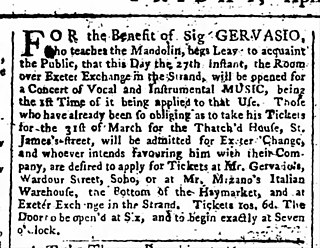
Giovanni Battista Gervasio was an Italian musician and composer. Born in Naples he was one of the first generation of virtuoso-mandolinists who left Italy and played the mandolin in Europe in the 18th century. He was a composer for the mandolin and his works can be found scattered in 18th century collections such as the Gimo music collection and the Bibliothèque Nationale de France. He also wrote a mandolin method Methode facile pour apprendre a quatre cordes, instrument pour les dames, published in Paris in 1767. He performed in London 1768 and in Frankfurt-on-the-Main in December 10, 1777 and the Concert Spirituel in Paris on December 24, 1784. He advertised in 1785 that he was master of singing and mandolin to Her Royal Highess, the Princess of Prussia. A work of music addressed to her exists today in the Bibliothèque Nationale de France.

Konrad Wölki was a German composer, mandolinist and music educator who contributed to the musically critical appreciation of the Zupforchesters. Historian Paul Sparks labeled Wölki "the founding father of modern German plucked-string music."

Mandolins evolved from the lute family in Italy during the 17th and 18th centuries, and the deep bowled mandolin, produced particularly in Naples, became common in the 19th century.

Following its invention and development in Italy the mandolin spread throughout the European continent. The instrument was primarily used in a classical tradition with mandolin orchestras, so called Estudiantinas or in Germany Zupforchestern, appearing in many cities. Following this continental popularity of the mandolin family, local traditions appeared outside Europe in the Americas and in Japan. Travelling mandolin virtuosi like Giuseppe Pettine, Raffaele Calace and Silvio Ranieri contributed to the mandolin becoming a "fad" instrument in the early 20th century. This "mandolin craze" was fading by the 1930s, but just as this practice was falling into disuse, the mandolin found a new niche in American country, old-time music, bluegrass and folk music. More recently, the Baroque and Classical mandolin repertory and styles have benefited from the raised awareness of and interest in Early music, with media attention to classical players such as Israeli Avi Avital, Italian Carlo Aonzo and American Joseph Brent.

















